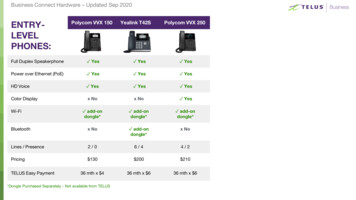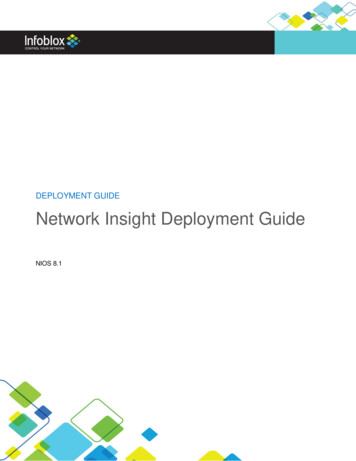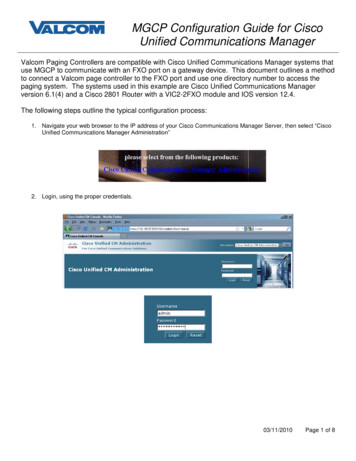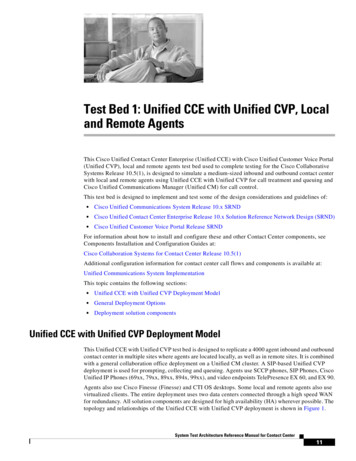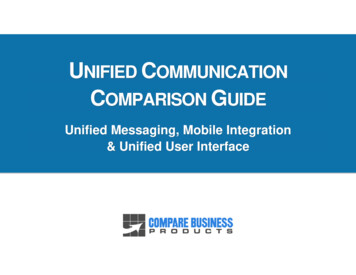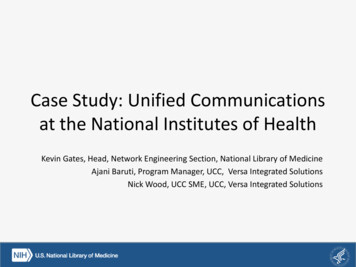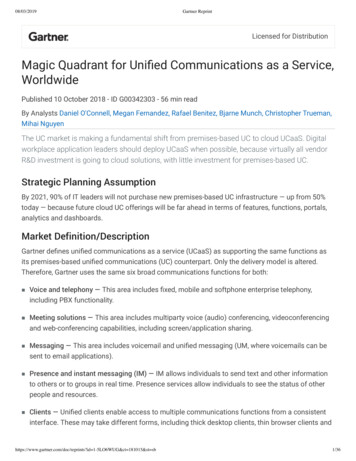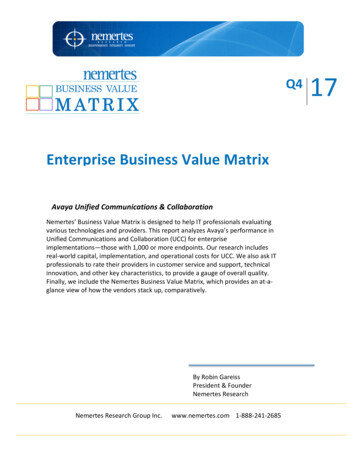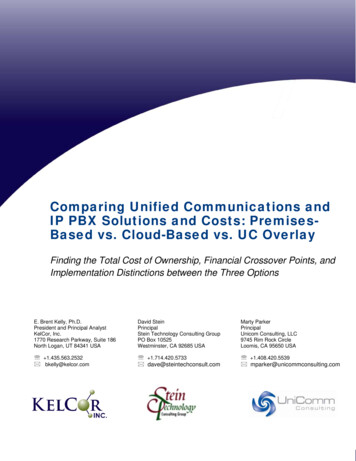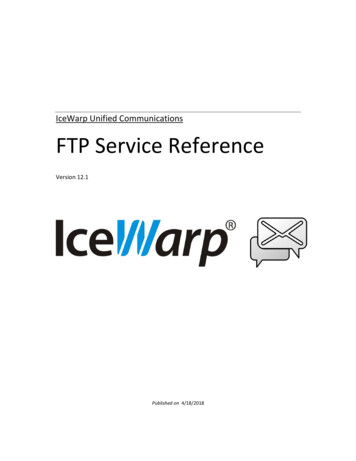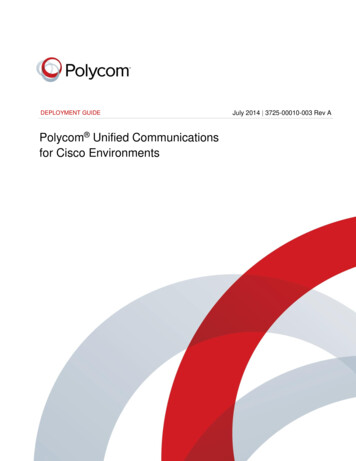
Transcription
DEPLOYMENT GUIDEPolycom Unified Communicationsfor Cisco EnvironmentsJuly 2014 3725-00010-003 Rev A
Copyright 2014, Polycom, Inc. All rights reserved. No part of this document may be reproduced, translated intoanother language or format, or transmitted in any form or by any means, electronic or mechanical, for any purpose,without the express written permission of Polycom, Inc.6001 America Center DriveSan Jose, CA 95002USAPolycom , the Polycom logo and the names and marks associated with Polycom products are trademarks and/orservice marks of Polycom, Inc. and are registered and/or common law marks in the United States and various othercountries. All other trademarks are property of their respective owners. No portion hereof may be reproduced ortransmitted in any form or by any means, for any purpose other than the recipient's personal use, without the expresswritten permission of Polycom.End User License Agreement By installing, copying, or otherwise using this product, you acknowledge that youhave read, understand and agree to be bound by the terms and conditions of the End User License Agreement forthis product.Patent Information The accompanying product may be protected by one or more U.S. and foreign patents and/orpending patent applications held by Polycom, Inc.Open Source Software Used in this Product This product may contain open source software. You may receivethe open source software from Polycom up to three (3) years after the distribution date of the applicable productor software at a charge not greater than the cost to Polycom of shipping or distributing the software to you. Toreceive software information, as well as the open source software code used in this product, contact Polycom byemail at OpenSourceVideo@polycom.com.Disclaimer While Polycom uses reasonable efforts to include accurate and up-to-date information in this document,Polycom makes no warranties or representations as to its accuracy. Polycom assumes no liability or responsibility forany typographical or other errors or omissions in the content of this document.Limitation of Liability Polycom and/or its respective suppliers make no representations about the suitability of theinformation contained in this document for any purpose. Information is provided “as is” without warranty of any kindand is subject to change without notice. The entire risk arising out of its use remains with the recipient. In no eventshall Polycom and/or its respective suppliers be liable for any direct, consequential, incidental, special, punitive orother damages whatsoever (including without limitation, damages for loss of business profits, business interruption,or loss of business information), even if Polycom has been advised of the possibility of such damages.Customer Feedback We are striving to improve our documentation quality and we appreciate your feedback. Emailyour opinions and comments to DocumentationFeedback@polycom.com.Visit the Polycom Support Center for End User License Agreements, software downloads, product documents,product licenses, troubleshooting tips, service requests, and more.2
ContentsContents . 3About This Guide . 6Conventions Used in this Guide . 6Terms and Writing Conventions . 6Information Elements . 7Typographic Conventions . 8Chapter 1: Get Started . 9Required Skills. 9Frequently Asked Questions .10What’s New? .10Get Help and Support Resources .10The Polycom Community.11Chapter 2: Polycom Unified Communications with Cisco Interoperability . 12Supported Deployment Models .12Direct Registration of Polycom RealPresence Systems with Cisco Unified CM .12Direct Secure Registration of Polycom RealPresence Systems with Cisco Unified CM .12Polycom RealPresence Platform SIP Integration with Cisco Unified CM .13Polycom RealPresence Platform Integration with VCS .13Polycom RealPresence Platform SIP Integration with Cisco CUBE SP Edition .13Chapter 3: Direct Registration of Polycom RealPresence Systems with CiscoUnified CM . 14Deployment Model Advantages .14Supported Products for Deployment .14Deployment Architecture .16Design Considerations.16Cisco Unified Communications Manager Considerations .16Polycom Immersive Telepresence Systems Considerations .17Share Content in Telepresence Environments .17License Devices .18Register a Polycom RealPresence Immersive, Room, or Desktop System with CiscoUnified CM.18Configure Cisco Unified CM for a Polycom Immersive, Room, or Desktop System .19Configure a Polycom Group Series System for Cisco Unified CM Registration .273
ContentsConfigure a Polycom HDX or Immersive System for Cisco Unified CM Registration .29Define your Polycom Immersive System in the Cisco TelePresence Server (Optional) .33Configure SIP Integration Between a Polycom RealPresence Collaboration ServerSystem and Cisco Unified CM .33Configure Cisco Unified CM for SIP Integration with RealPresence Collaboration Server .34Configure the RealPresence Collaboration Server for Cisco Unified CM SIP calls .37Prepare the RealPresence Collaboration Server to Support TIP Calls (Optional) .40Troubleshoot .47Chapter 4: Direct Secure Registration of Polycom RealPresence Systems withCisco Unified CM . 49Deployment Model Advantages .49Supported Products for Deployment .50Deployment Architecture .51Design Considerations.51Cisco Unified Communications Manager Considerations .51Polycom Immersive Telepresence Systems Considerations .52Content Sharing in Telepresence Environments .52License Devices .53Secure Media Methods .53Securely Register a Polycom RealPresence Immersive, Room, or Desktop System withCisco Unified CM .54Configure Cisco Unified CM for a secure Polycom Immersive, Room, or Desktop System 55Configure a Polycom HDX or Immersive System for Cisco Unified CM Registration .62Define your Polycom Immersive System in the Cisco TelePresence Server (Optional) .67Troubleshoot .68Chapter 5: Polycom RealPresence Platform SIP Integration with Cisco Unified CM. 69Supported Products for Deployment .69Deployment Architecture .71Design Considerations.71Use a Dial Plan .71Use Call Admission Control .71Share Content.71Configure SIP Integration between a Polycom DMA System and Cisco Unified CM .72Configure Cisco Unified CM for SIP Integration with DMA .73Configure DMA for SIP Integration with Cisco Unified CM .79Troubleshoot .84Chapter 6: Polycom RealPresence Platform Integration with VCS . 87Deployment Model Advantages .874
ContentsSupported Products for Deployment .87Deployment Architecture .88Design Considerations.89Dial Plan .89Call Admission Control.89Protocol Conversion.90Configure SIP Integration Between a Polycom DMA System and VCS .90Configure VCS for SIP Integration with DMA .90Configure DMA for SIP Integration with VCS .93Configure H.323 Integration between a Polycom DMA System and VCS .97Configure VCS for H323 Integration with DMA.97Configure DMA for H323 Integration with VCS.101Troubleshoot .104Chapter 7: Polycom RealPresence Platform SIP Integration with Cisco CUBE SPEdition . 106Deployment Model Advantages .106Supported Products for Deployment .107Deployment Architecture .108Design Considerations.108Configure SIP Integration between a Polycom DMA System and CUBE SP Edition .109Configure CUBE SP for SIP Integration with DMA .109Configure DMA for SIP Integration with CUBE SP .110Troubleshoot .115Configuration Example . 1175
About This GuideThis deployment guide uses a number of conventions that help you to understand informationand perform tasks.Conventions Used in this GuideThis guide contains terms, graphical elements, and a few typographic conventions. Familiarizingyourself with these terms, elements, and conventions helps you complete tasks.Terms and Writing ConventionsThe following terms are used in this deployment guide.Polycom ComponentsDMAPolycom RealPresence Distributed Media Application (DMA )HDXPolycom HDX ITPPolycom Immersive TelepresenceRealPresence Collaboration ServerPolycom RealPresence Collaboration Server (RMX)OTXPolycom Open Telepresence Experience MLAPolycom Multipoint Layout ApplicationCisco ComponentsCisco Unified CMCisco Unified Communications ManagerCTSCisco TelePresence SystemTXCisco TelePresence SystemTPSCisco TelePresence ServerVCSCisco TelePresence Video Communications Server6
About This GuideGeneral Industry:SIPSession Initiation ProtocolTIPTelepresence Interoperability ProtocolInformation ElementsThe following icons are used to alert you to important information in this guide.Icons Used in this GuideNameIconDescriptionNoteThe Note icon highlights information of interest or important informationneeded to successfully complete a procedure or understand a concept.Administrator TipThe Administrator Tip icon highlights techniques, shortcuts, orproductivity-related tips.CautionThe Caution icon highlights information you need to know to avoid ahazard that could potentially impact device performance, applicationfunctionality, or successful feature configuration.WarningThe Warning icon highlights an action you must perform or avoid toprevent information loss, damage your configuration setup, and/or affectcomponent or network performance.Web InfoThe Web Info icon highlights online information such as documents ordownloads.TimesaverThe Timesaver icon highlights a faster or alternative method foraccomplishing task.Power TipThe Power Tip icon highlights a faster or alternative method foradvanced administrators.TroubleshootingThe Troubleshooting icon highlights information that can help you solvea problem or refer you to troubleshooting resources.SettingsThe Settings icon highlights settings you might need to choose oraccess.7
About This GuideTypographic ConventionsA few typographic conventions, listed next, are used in this guide to distinguish types of in-textinformation.Typographic ConventionsConventionDescriptionBoldHighlights interface items such as menus, soft keys, file names, anddirectories. Represents menu selections and text entry to the phone.ItalicsEmphasizes text, shows example values or inputs, and shows titles ofreference documents available from the Polycom Support web site andother reference sites.Blue TextIndicates URL links to external web pages and internal hyperlinks tolocations within the document.Fixed-width-fontRepresents code fragments and parameter names.8
Chapter 1: Get StartedThis deployment guide explains how to integrate Polycom Unified Communications (UC)products into Cisco environments. Each chapter focuses on a distinct architecture, and eachchapter contains a list of the Cisco and Polycom products tested with that architecture. Thisdeployment guide is intended for administrators integrating Cisco with Polycom products and forsupport personnel working with customers to set up the solutions described in this guide.This deployment guide focuses on several Cisco call control infrastructure scenarios. Cisco Unified Communications Manager (Cisco Unified CM) CUCM is Cisco’s UC platform providingInternet Protocol (IP) telephony and advanced features. It is a multiprotocol-capable platformthat has been migrating towards SIP endpoint connectivity. Cisco Video CommunicationsServer (VCS) was inherited via Cisco’s acquisition of Tandberg, and has historically providedH.323 and SIP call control for video endpoints.Polycom’s integrated suite of hardware devices and software applications enables you tointegrate video and audio communications across Cisco platforms and provides Polycomcustomers new deployment opportunities and investment protection for existing deployments.Web Info: See the Release Notes for Polycom Unified Communications forCisco EnvironmentsFind the latest release notes for Polycom Unified Communications for CiscoEnvironments at Polycom Unified Communications with Cisco.Required SkillsIntegrating Polycom infrastructure and endpoints with Cisco Unified Communications Managerenvironments requires planning and elementary knowledge of Polycom video conferencing andvideo conferencing administration.Polycom assumes readers of this guide have a basic understanding Session Initiation Protocol(SIP) and Telepresence Interoperability Protocol (TIP), as well as Cisco and Polycomcomponent base functions. Users should be comfortable navigating and configuring Ciscocomponents such as Cisco Unified CM, VCS, and other infrastructure components.Administrators should have knowledge of the following third-party products: Cisco Unified Communications Manager (Cisco Unified CM) Cisco Video Communications Server (VCS)9
Get Started Cisco video and voice endpointsFrequently Asked QuestionsThis section answers questions you might have about the solution before you begin.Is a Telepresence Interoperability Protocol (TIP) license required on the RealPresenceCollaboration Server bridge for Cisco environments?No. TIP capability is built into the Polycom RealPresence Collaboration Server. However, if animmersive telepresence experience is required on, for example, multiscreen Polycom or Ciscoendpoints, there is a telepresence license enabling TIP capability on the RealPresenceCollaboration Server. Polycom RealPresence Collaboration Server can host immersive as wellas nonimmersive video conferences.Can a Polycom RealPresence solution integrate with a Cisco Video CommunicationsServer (VCS)?Yes. Refer to Polycom RealPresence Platform Integration with VCS for information on CiscoVCS integration deploym
Server (VCS) was inherited via Cisco’s acquisition of Tandberg, and has historically provided H.323 and SIP call control for video endpoints. Polycom’s integrated suite of
